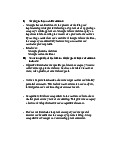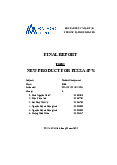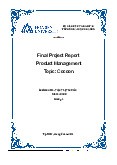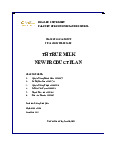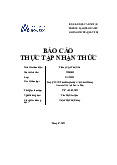



















Preview text:
1 In order to maximize diversification benefits, an investor B
Choice B is correct. The maximum diversification benefits can be
should add a security with a correlation to the existing
achieved by adding a security with a correlation of -1.0 (perfectly portfolio closest to: negatively correlated). A. 0.0.
Choice A is not the best answer in that although diversification benefits B. -1.0.
occur any time an investor adds a security with correlation to the C. 1.0.
portfolio less than 1, adding uncorrelated (zero correlation) assets does
not achieve the maximum diversification benefits.
Choice C is incorrect in that adding perfectly positively correlated
assets have no diversification effect. Nevertheless, instead of adding
(longing) assets, shorting positively correlated assets provides diversification benefits.
2 An analyst gathers the following data about the returns B
Choice B is correct. The correlation is calculated according to the for two stocks. following equations: . Stock A Stock B Expected 5% 8% Return
Note: there are two formulas similar to the above: Variance 0.36% 0.81% Beta coefficient:
The covariance between returns on stocks A and B is
, M denoted as the market portfolio.
0.12%. The correlation between the returns of Stock A and Stock B is closest to: A.
Coefficient of determination: 0.16. B. 0.22. C. 0.33.
3 When constructing unleveraged portfolios consisting of A
Choice A is correct. The efficient frontier represents the set of
only risky assets, investors should only consider the set of
portfolios of risky assets having the maximum return at any level of y y , y portfolios that:
risk. This set of portfolios dominate any other portfolios or risky assets A. and individual risky assets.
reside on the efficient frontier. B.
are minimum variance portfolios.
Choice B is incorrect. The minimum variance portfolios represent
C. reside on the capital market line.
portfolio of risky assets having the minimum risk at any level of
return. Since the minimum variance set is concave in the framework
of return and standard deviation, there are two minimum variance
portfolios given at any level of risk (standard deviation).
Choice C is incorrect in that portfolios reside on the capital market line
must have position (either long or short) on the risk-free asset.
4 A stock has a beta of 0.92 and an estimated return of A
According to the CAPM the required return of the stock is E(R) = 3%
11%. The risk-free rate is 3%, and the expected return on
+ 0.92(12% - 3%) = 11.28%. Because the expected return of 11% is
the market is 12%. According to the CAPM, this stock:
less than the required return of 11.28%, the security is
overvalued. The stock value is the discounted value of future A. is overvalued.
dividends. When the discount rate is lower than it should be (11% < B. is undervalued.
11.28%), the current price is overvalued. C. is properly valued.
Note that the required return by the investor is the cost of capital to the
firm. Investors require premium to compensate risk of
investment. Thus, the required return is equal to the risk-free return
plus risk premium. According to the CAPM, the risk premium
isBeta×Market Risk Premium.
5 The relevant measure of risk for the capital market line A
Choice A is correct. The beta in the SML equation is derived from the
(CML) and security market line (SML) rely on which of
covariance between portfolio’s returns and market returns divided by
the following for their measure of risk:
the variance of the market portfolio. The capital market line (CML)
shows the relationship between the required returns on efficient
A. Standard deviation for CML and covariance for SML.
portfolios (rather than individual securities) and their total risk B. Covariance for CML and SML.
measured as standard deviation.
C. Covariance for CML and standard deviation for SML.
Choice B is incorrect in that CML is in the framework between
expected return and standard deviation.
Choice C is incorrect. It should be stated that "Standard deviation for CML and covariance for SML."
6 Which of the following least accurate regarding the B
Choice "B" is incorrect. Portfolios lie on the CML are a combination of capital market line (CML)?
the market portfolio and the risk-free asset with different A.
allocation. Since the CML is above the efficient frontier in mean-
The Sharpe ratio of any portfolios lies on the CML
standard deviation framework, the CML portfolios dominate those on
has the same Sharpe ratio of the market portfolio. the efficient frontier.
B. All portfolios lie on the CML are as efficient as those lie on the efficient frontier.
Choice A is correct in that the slope of CML is the Sharpe ratio of the C.
market portfolio. All points in a line have the same slope. Thus, all
The CML contains the set of all efficient portfolios,
but all portfolios and all stocks lie on the security
portfolios lies on the CML have the same Sharpe ratios.
market line in an efficient market that is in
Choice C is correct because only efficient portfolios lie on the capital equilibrium.
market line. However, all portfolios and all stocks lie on the security
market line in an efficient market that is in equilibrium. This is because
the capital market line is the relationship between expected return and
total portfolio risk, while the security market line is the relationship
between expected return and the systematic component of risk (which
is what the market compensates the investor for taking).
7 The goal of diversification under the traditional B
Choice B is correct. Unsystematic risk is unique to a particular security
portfolio theory is to minimize:
and can be diversified in a portfolio through adding additional A. uncorrelated assets. Systematic risk. B. Unsystematic risk.
Choice A is incorrect in that systematic risk is the only risk remaining C. Beta.
in a fully diversified portfolio (such as the market portfolio).
Choice C is incorrect in that minimizing beta at the extreme
would only result in an investor receiving the risk-free rate and would
only apply to an investor wishing the risk-free rate (which could be
achieved more efficiently by investing in the risk-free asset).
8 There are two statements about portfolio C
Statement 1 is incorrect in that the investment policy statement is an management process:
integral part of the portfolio management process. The investment
policy statement guides the entire investment process.
Statement 1: The investment policy statement is an
Statement 2 is not consistent with the portfolio management process.
initial step of the portfolio management process. The
The primary purpose of the monitoring process is to determine whether
investment process should be changed according to
or not the portfolio manager is staying within the constraints imposed the change of market trends.
by the investment policy and whether or not the expected return on the
portfolio is likely to be maximized within those constraints based on
new capital market expectations and current needs and circumstances
Statement 2: The primary purpose of the monitoring
of the investor. This is much more complex than simply attempting to
process in portfolio management is to measure the
beat the stock market's overall performance.
performance of a client's portfolio relative to the
performance of the stock market benchmark over a comparable period of time.
A. Only statement 1 is accurate.
B. Only statement 2 is accurate.
C. Both statements are inaccurate.
9 An analyst gathered the following information about a C
Choice is correct in that portfolio expected return is
portfolio comprised of two assets, X and Y: Asset Expected Expected W eight (%) R eturn Standard Deviation
=(0.75 × 1%) + (0.25 × 7%) = 2.5%, and X 75% 1% 5%
portfolio expected standard deviation of two assets is calculated by: Y 25% 7% 4% =
If the correlation of returns for the two assets equals
0.75, and the risk-free interest rate 1 percent, then the
Sharpe ratio of this portfolio is closest to:
= [(0.752 × 0.052) + (0.252 × 0.042) + (2 × 0.75 × 0.25 × 0.75 × 0.05 × 0.04)]0.5 = 4.55%; A. 0.95 B. The Sharpe ratio = (2.5% - 1%)/4.55% = 0.33. 0.67 C. 0.33
Note that Sharpe ratio can be interpreted as "risk-adjusted excess
return" or "portfolio’s risk-premium per unit of risk (standardized risk- premium).
10 Which of the following constraints would most B
Choice is correct in that in developing IPS, unique needs and
likelyappear in the unique needs and preferences section
preferences include the prohibition of certain investments. The
of a trust’s investment policy statement (IPS) ? The
investment constraints of liquidity, tax concerns, and legal and
regulatory factors adequately address the portfolio’s other constraints. portfolio is:
A. subject to the prudent-man standard.
Choice A is incorrect, because prudent-man standard is a judiciary
B. prohibited from investing in tobacco companies.
responsibility of portfolio managers not the unique needs of investors. C.
This fiduciary is required to invest trust assets as a "prudent
prohibited from holding less than 5% in cash instruments. man" w
ould invest his own property with the following factors in
mind: (1) the needs of beneficiaries; (2)
the need to preserve the estate (or corpus of the trust); and (3)
the amount and regularity of income.
Choice C is incorrect in that the prohibition from holding less than 5%
in cash instruments is related to investor risk aversion not the
uniqueness of asset allocation requirement.
11 A stock has a beta of 1.2 and an estimated return of 11%. A Acording to CAPM, = 3% + 1.2(12% - 3%) =
The risk-free rate is 3%, and the expected return on the
market is 12%. According to the CAPM, this stock:
13.8%. Because the expected return of 11% is less than the required A.
return of 13.8%, the security is overvalued. Note that the stock value is overvalued. B.
is a discounted value of future cash flows. The discounted rate is the is undervalued.
required return by the investor. It is also the cost of capital to the C. is properly valued.
firm. Lower the discounted rate (required return or cost of capital), higher the stock value.
12 The type of return objective least likely to be used in an B
Choice B is incorrect because although a return object can be related to
investment policy statement is a(n):
a benchmark return such as 1.5% above S&P 500 index, it is not A.
termed a benchmark return objective. total return objective. B. benchmark return objective. Choice A is correct. The total return C. absolute return objective.
including reinvested orrecapitalized return could be a return objective in the IPS. .
Choice C is correct. Return objectives in an investment policy
statement can take the form of an absolute objective, such as 8%.
13 In a case where a client's capacity to bear risk is B
In a situation where the clients expressed willingness to bear
significantly less than the client's expressed willingness
investment risk is significantly greater than the client’s ability to bear
to bear risk, the most appropriate action for a financial
investment risk, the advisor's assessment of the client's risk tolerance
in the IPS should relate the clients ability to bear investment risk. advisor is to:
A. counsel the client and attempt to change his attitude
Choice A is incorrect. Financial advisor should not attempt to change towards risk.
the client’s attitude toward risk. B.
base the assessment of risk tolerance in the IPS on client's ability to bear risk.
Choice C is incorrect. It depends, if clients risk behavior involves C.
"emotional bias" such as loss aversion or overconfidence, financial
attempt to educate the client about investment risk
advisor should adopt the bias instead of providing education about
and correct any misconceptions. investment.
14 Which of the following pairs least likely refer to the same C
Unsystematic risk is diversifiable risk. Investors are able to eliminate type of risk?
unsystematic risk by forming diversified portfolios. A.
Total risk and the variance of returns.
Choice A is correct; variance is a measure of total risk.
B. Residual variance and firm-specific risk.
A. Undiversifiable risk and unsystematic risk.
Choice B is correct in that the residual variance under the market
model is a measure of idiosyncratic (or firm-specific) risk.
15 Which of the following statements about risk A
The capital market line plots expected return against standard deviation is least accurate:
of returns. The standard deviation of return is a measure of total risk A. not the market risk.
The capital market line plots expected return against market risk.
Choice B is accurate. The efficient frontier represents efficient
B. The efficient frontier plots expected return against
portfolios of risky assets. The efficient frontier plots expected return total risk. against total risk. C.
The security market line plots expected return against systematic risk.
Choice C is accurate. The security market line (CAPM) represents the
equilibrium of risk-adjusted required return for individual assets. It
plots expected return against systematic risk, which is measured by the beta coefficient (β).
16 Which of the following possible portfolios cannot lie on B
Neither portfolio 1 nor portfolio 2 lies on the efficient the efficient frontier?
frontiers. Efficient frontier contains a set of efficient
portfolios. Portfolios are efficient in that no portfolio in the set
dominates each other. Portfolio 2 is dominated by portfolio 1 in that Expected Standard
the standard deviation of portfolio 1 is lower than that of portfolio Portfolio R eturn D eviation
2. However, portfolio 1 is dominated by the portfolio 3. It is because 1 5% 16%
although both portfolios 1 and 3 have the same standard deviations, 2 5% 18%
portfolio 3 has a higher expected return. 3 7% 16% 4 9% 20%
Choice A is incorrect because it ignores that portfolio 1 is also a dominated portfolio. A. Portfolio 2 only. B.
Choice C is incorrect that portfolio 4 is an efficient portfolio in this Portfolios 1 and 2.
set. There is no portfolio dominates portfolio 4. So, portfolio could lie C. Portfolios 2 and 4. on the efficient frontier.
17 Unimark Inc. stock pays $1 dividend annually and B
Unimark's expected return for the coming year is [(28+1) / 25] - 1 =
currently trades at $25. Based on the CAPM and 16%. According to CAPM,
assuming an expected return on the market of 13% and a or .
risk-free rate of 5%, the expected price for Unimarkone
year from now is $28. The beta of Unimark shares is
Its risk premium relative to the risk-free rate is 16% - 5.0% = 11%. closest to:
The market risk premium is 13% - 5% = 8%. Therefore, the beta A. 0.88
ofUnimark must be 11% / 8% = 1.38. Note that the divided must be B. 1.38 included in calculation. C. 1.68
18 A portfolio manager is constructing a new equity C
As randomly selected securities are added to a portfolio, the
portfolio consisting of a large number of randomly
diversifiable (unsystematic) risk decreases, and the expected level of
chosen domestic stocks. As the number of stocks in the
non-diversifiable (systematic) risk remains the same.
portfolio increases, what happens to the expected levels
Note that the above is adding randomly long positions (buying
of systematic and unsystematic risk?
securities). If there is long-short position, meaning buying and
shorting securities at the same time, the systematic risk may S
ystematic risk Unsystematic risk
decrease. It is because the long and short positions have a negative A.
correlation. The negative correlation among assets' positions will Increases Remains the same B.
reduce even eliminate systematic risk. Decreases Increases C. Remains the same Decreases
19 Using historical index returns for an equities market over C
Note that the total holding period return is a compounded value of
a 10-year period, an analyst has calculated the average
annual return over the entire period of years such that
annual return as 8.46% and the holding period return as ; 2.3 = (1+AR)10 ;
130%. The compound annual index return over the period is closest to: A. 8.32%. Solve for AR, and AR = 8.69% B. 8.58%. C. 8.69%.
20 Jeff Bishop, CFA, is meeting with one of his portfolio C
There are five categories of investment constraints: Time, Tax,
management clients, Paul Wu to discuss Paul's
Liquidity, Legal, and Unique (TTLLU).
investment constraints. Jeffl has established that:
The four matters listed are related to
Wu plans to retire from his job as a bond salesman in
(1) Wu's time horizon (years to retirement).
15 years, after which this portfolio will be his primary
(2) liquidity needs (available cash). source of income.
(3) legal and regulatory factors (required copies of account
statements to Pope's compliance officer).
Wu may not have sufficient cash available that he will
need this portfolio to generate cash outflows until he
(4) tax situation (Jeff owns low cost stocks and will have to pay retires.
high capital gain tax when he sells the stocks.).
Wu, as a registered securities representative, is required
However, none of these constrains address Wu's unique needs and
to have Jeff send a copy of his account statements to preferences.
the compliance officer at Paul’s employer.
Jeff owns low cost stocks from his company when he joined the firm 15 years ago.
To complete his assessment of Pope's investment
constraints, Samuel still needs to inquire about Pope's: A. tax concerns. B. liquidity needs.
C. unique needs and preferences.
21 When a risk-free asset is combined with a portfolio of A
The correlation between a risky asset and a risk-free asset is
risky assets, which of the following is most correct?
zero. Thus, the answer B is incorrect. Since the correlation between y , g
A. The standard deviation of the return for the newly
these assets is zero, the covariance is also zero. Note that the variance
created portfolio is the standard deviation of the
(or standard deviation of the risk-free asset is equal to zero). Then, the
returns of the risky asset portfolio multiplied by its
standard deviation of the portfolio is . portfolio weight.
Answer C is incorrect in that the portfolio variance is weight-square
B. The expected return for the newly created portfolio
times the variance of the risky asset.
and correlation coefficient between the two assets are positive.
C. The variance of the resulting portfolio is a weighted
average of the returns variances of the risk-free asset
and of the portfolio of risky assets.
22 If stock A’s beat is 1.2 and stock B’s beta is 0.9. Both B
From the single index (market) model, the correlation between returns
stocks have the same standard deviation of returns of
on stock A and stock B is calculated by
30%. The standard deviation of the returns on the market = (1.2)(0.9)(.28)2 =0.08467.
portfolio is 14%, the correlation between stock A and stock B is closest to: A. 88% Since statistically, , B. 94%. C. 97%
the correlation coefficient is 0.08467÷(0.3×0.3) = 0.94.
23 Betty Cole is an aggressive investor. She has $100,000 C
This is a question that borrowing and lending rates are different (which
capital but is borrowing additional $50,000 to invest in
is quite realistic). Cole’s portfolio is a leveraged portfolio with a
S&P500 index fund. Although the current risk-free rate
leverage ratio (λ) of 1.5. Consider that Shape Ratio of a leveraged
portfolio can be calculated from the following equation:
is only 1%, her borrowing rate is 2%. The current
expected return and standard deviation of S&P 500 index
are 10% and 20%, respectively. What is the expected
Sharpe ratio of Cole’s portfolio? A. 0.45
